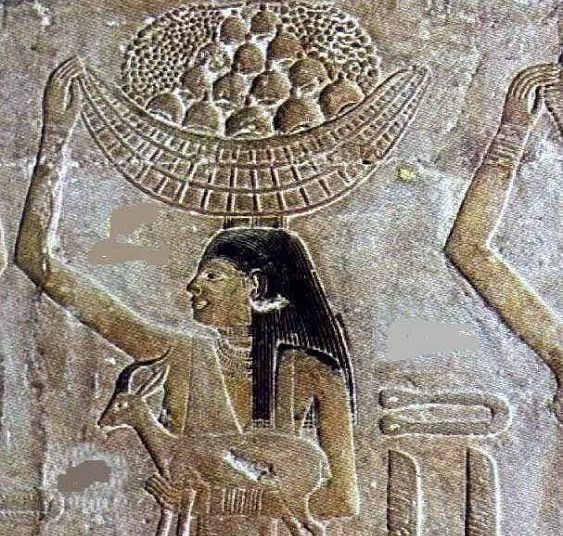Egyptian cuisine is widely celebrated for its assortment of flavourful dishes. Among these culinary delights, Kahk stands out as a delectable indulgence that holds a special place in the hearts of Egyptians. With a history dating back centuries, this sweet biscuit is more than just a dessert; it is a symbol of cultural heritage and joyous celebrations during Eid El-Fitr (Lesser Bairam), a festive occasion marking the end of Ramadan.
The origins of Kahk can be traced back to the time of the Pharaohs, making it a treat with a rich and fascinating history. In ancient Egypt, these ring-shaped biscuits were offered as sacred offerings to the gods during religious rites and celebrations. They were believed to signify good fortune and prosperity.
Evidence of the ancient Egyptians’ mastery of cookie-making can be found in the tomb of Rekhmire, an official of the 18th Dynasty. The drawings within his tomb reveal the process of making Kahk, which involved mixing honey with ghee and heating it over a fire. This mixture was then combined with flour, forming a dough that was easily shaped onto slate boards and baked in ovens. Some cookies were even fried in ghee or oil.
The cookies of ancient Egypt were round in shape, resembling the sun, and often adorned with golden lines that represented sun rays. The ancient Egyptians were renowned for their skill in crafting cookies into intricate geometric and decorative shapes, including animals and tree leaves. They would even depict the image of the god Ra, symbolised as a sun disk, on the cookies.
The tradition of making cookies persisted over the centuries, influenced by the Greek, Roman, and Byzantine eras. It reached its peak during the Islamic period, particularly during the Tulunid state in Egypt from 868 to 904 AD. During this time, special molds were used, and cookies became an integral part of Eid al-Fitr celebrations.
In the era of Ikhshidid rule, the practice of gifting golden dinars hidden within cookies to the poor was carried out on a large scale. These cookies were presented on a table that measured 200 meters long by 7 meters wide.
During the Fatimid Caliphate in Egypt, which spanned from 909 to 1171 AD, the celebration of religious holidays, including Eid al-Fitr, held particular importance. The Caliph personally allocated 20,000 dinars to finance the production of Eid cookies. A unique establishment called “Dar Al-Fatna” was created solely for the purpose of making these cookies.
Despite the efforts made by Sultan Saladin in the 12th century to suppress the customs of the Fatimids, he was unsuccessful in eradicating the tradition of baking Eid al-Fitr cookies and other culinary customs. This time-honored tradition endured throughout the Mamluk and Ottoman eras.
In the Mamluk era, which took place from 1250 to 1517 AD, the tradition of charitable cookie distribution continued. Princes partook in distributing cookies to the less fortunate and Sufis, particularly at the Princess Tatar Al-Hijaziya School located in the Al-Jamaliyya neighborhood. This period witnessed the popularisation of cookie making, leading to the creation of the famous “Hallawiyyin” Market in Bab Zuweila. Vendors would proudly exhibit diverse varieties of cookies during the final ten days of Ramadan, often employing innovative molds.
The Museum of Islamic Art in Cairo is home to an exquisite collection of molds used for making cookies. These molds bear meaningful phrases such as “Eat well and be grateful” and “Eat and thank your Lord.” One notable phrase stems from an encounter between Sultan Qaytbay and the Sharif of Mecca, where the latter sent a delightful table of sweets to the Sultan during his Hajj journey. When inquired about its name, the commander of the Sharif of Mecca responded with the phrase “Eat and give thanks.”

In the more contemporary period, immigrants from the Levant region who settled in Egypt during the 19th and 20th centuries played a vital role in the advancement of the confectionery industry, particularly in the development of Eid cookies and biscuits. Modern techniques emerged, including the utilization of modern tools instead of traditional burins to intricately carve the cakes before baking them in nearby ovens.
Kahk, the treasured sweet treat enjoyed throughout Egypt, is often filled with a mixture of nuts, dates, or a combination of ingredients. A generous dusting of powdered sugar adds to its beauty and appeal.
While Kahk is adored across the entirety of Egypt, each region boasts its own unique variations. In Alexandria, for instance, the biscuits are often crafted in the shape of crowns or crescents, filled with a delectable mixture of honey, nuts, and spices. Conversely, in Cairo, Kahk is commonly prepared with a combination of ghee, powdered sugar, and sesame seeds.
Egyptian families have passed down their cherished Kahk recipes throughout generations, ensuring the preservation of this beloved tradition. The process of baking Kahk is a labour of love that often involves the whole family. From the preparation of the dough to the shaping and filling of the biscuits, the entire procedure is a joyous occasion filled with laughter and togetherness.
While the essence of Kahk remains deeply rooted in its ancient origins, modern adaptations have emerged to cater to evolving tastes. Some bakers are experimenting with new and exciting flavours, such as chocolate or pistachio fillings, while still maintaining the traditional elements that make Kahk truly unique.
Kahk represents more than just a delectable biscuit; it stands as a cultural symbol that has withstood the test of time, connecting Egyptians to their past and present. From its earliest beginnings as a religious offering to its current role as an essential part of celebratory occasions, Kahk embodies the spirit of celebration and unity.







Discussion about this post